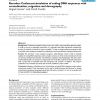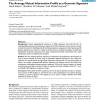104
click to vote
TCBB
2008
15 years 21 days ago
2008
Abstract-- The Maximum Parsimony problem aims at reconstructing a phylogenetic tree from DNA sequences while minimizing the number of genetic transformations. To solve this NP-comp...
85
Voted
NAR
2006
15 years 22 days ago
2006
Individual zinc finger (ZF) domains that recognize DNA triplets with high specificity and affinity can be used to create designer transcription factors and nucleases that are spec...
97
Voted
BMCBI
2007
15 years 24 days ago
2007
Background: Features of a DNA sequence can be found by compressing the sequence under a suitable model; good compression implies low information content. Good DNA compression mode...
116
Voted
BMCBI
2007
15 years 24 days ago
2007
Background: Coalescent simulations have proven very useful in many population genetics studies. In order to arrive to meaningful conclusions, it is important that these simulation...
125
Voted
BMCBI
2006
15 years 25 days ago
2006
Background: Recent advances and automation in DNA sequencing technology has created a vast amount of DNA sequence data. This increasing growth of sequence data demands better and ...
125
Voted
BMCBI
2008
15 years 27 days ago
2008
Background: Data mining in large DNA sequences is a major challenge in microbial genomics and bioinformatics. Oligonucleotide usage (OU) patterns provide a wealth of information f...
124
Voted
BMCBI
2008
15 years 27 days ago
2008
Background: Motif finding algorithms have developed in their ability to use computationally efficient methods to detect patterns in biological sequences. However the posterior cla...
82
Voted
BMCBI
2008
15 years 27 days ago
2008
Background: There are several situations in population biology research where simulating DNA sequences is useful. Simulation of biological populations under different evolutionary...
113
click to vote
BMCBI
2008
15 years 27 days ago
2008
Background: Occult organizational structures in DNA sequences may hold the key to understanding functional and evolutionary aspects of the DNA molecule. Such structures can also p...
113
click to vote
BMCBI
2010
2010
An intuitionistic approach to scoring DNA sequences against transcription factor binding site motifs
15 years 27 days ago
Background: Transcription factors (TFs) control transcription by binding to specific regions of DNA called transcription factor binding sites (TFBSs). The identification of TFBSs ...



